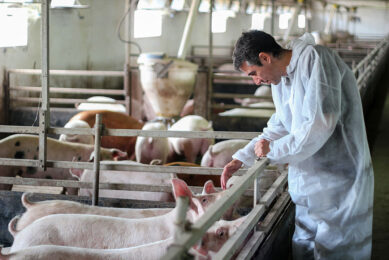7 EU antibiotic remarks that need clarification

Antimicrobial usage in the pig and other livestock industries is under ongoing scrutiny by the European Parliament. That the parliament in a press release speaks of ‘superbugs’ puts this legislative body in the same group as doubtful media, according to David Burch. He sums up 7 statements that scream for further clarification.
The actual press release was entitled “Superbugs: MEPs want to curb use of antibiotics in farming”. The document was on ‘Regulation: Veterinary medicinal products.’
Grasping antibiotic resistance at its roots
There were a number of dramatic statements in the press release, which are cause for concern that are attributed to the legislators themselves. There is concern that antibiotic resistance would cause more deaths but is it correct to say ‘it is time we took energetic measures and grasped the problem at its roots’?
Is animal health use of antibiotics really the root of the problem or could it possibly be human use of antibiotics that is causing the main problem in man? I think you know my views (0.27% animal use; 99.73% human use).
7 Comments on antibiotics
Grossetête (EPP, FR), the rapporteur for the legislation came out with a number of comments:

“We wish to prevent purely preventive use of antibiotics.”
I think this is already accepted by member states and does not appear to be defended by governments (see weblog ‘Prevention out – Treatment in‘). It is interesting that COPA-COGECA (farmers and cooperatives) are requesting that prevention is retained – good luck.

“Restrict collective treatment to very specific cases.”
I am not completely sure what that means, but might involve prevention and metaphylaxis of groups of animals, see later.

“Prohibit the veterinary use of antibiotics that are critically important for human medicine.”
This is a worry as they seem to favour the World Health Organization (WHO) list, which effectively bans almost all antibiotics for vet use, except 2 growth promoters. (See weblog – ‘Classification of antimicrobials – a clash of views‘). At the moment there is a dichotomy of views regarding the recommendations between WHO and the European Medicines Agency (EMA) and I am surprised that they are not supporting their own EU body.

“Put an end to online sales of antibiotics, vaccines and psychotropic substances.”
I am not sure how much this contributes to antibiotic use, presumably, they would need a veterinary prescription for antibiotics so should not be a major impact, if legally sold.

“We hope to reduce the amounts of antibiotics found on consumers’ plates.”
This is a particularly cheap shot at meat producers and farmers, who obey withdrawal periods and ensure a wholesome product is supplied. I hope the European Food Safety Authority (EFSA) reprimand her and demand an apology, as it implies that their system is not working. With all the monitoring of meats for antibacterial residues that goes on, it is a relatively rare finding (EFSA, 2013). Of a total of 772,540 samples taken, of those tested for antibacterials only 0.18% were reported non-compliant (0.13% for pigs, 0.12% poultry, bovine 0.24% and 1.5% for honey).

“We need not reduce the therapeutic arsenal available to vets.”
This does not join up with ‘3’ where they talk about banning the use of critical antibiotics.

“It is absolutely necessary to encourage research and innovation in this sector.”
One could add ‘to compensate for the major disturbance and loss of products that this legislation potentially could cause’. One could also add ‘will anybody in the pharmaceutical industry take the risk to develop a brand new antibiotic’? It seems unlikely.
Antimicrobials reserved for human treatment
A further statement made ‘To help tackle resistance, the revised law would empower the European Commission to designate antimicrobials which are to be reserved for human treatment.’
There is already a discussion about colistin going on at the moment; 3rd and 4th generation cephalosporins have been the focus of much controversy and are also being examined. They cleverly added a link to a recent report from the European Centre for Disease Control (ECDC) where ‘Scientists say that resistance to ciprofloxacin (fluoroquinolone), an antimicrobial that is critically important for treating human infections, is very high in Campylobacter.’ Is this going to be another major target in the future?
Resistance to macrolides
It does not mention that resistance to macrolides (another critically important family of antibiotics) by C. jejuni, the major Campylobacter infection in man, is very low and co-resistance to both fluoroquinolones and macrolides is also very low at 0.3% (ECDC/EFSA, 2016) in man, so is unlikely to have a major effect on treatment. Personally, I think it would be more productive to focus efforts on reducing broiler carcass contamination with Campylobacter. EFSA have been very successful in reducing reported Salmonella infections by over 50% in man from poultry in the EU, which is half the number of Campylobacter infections.
Detailed changes on regulations
There are some detailed changes in the amended document ‘Regulation: Veterinary medicinal products’
Regarding preventive use (see ‘1’ above):
(34a) The routine prophylactic and metaphylactic use of antimicrobials on groups of food-producing animals should be brought to an end. Disease should be prevented not by routine recourse to antimicrobials but by good hygiene, husbandry and housing, and sound management practices.
They have included metaphylaxis with prevention, even though there are diseased animals present, by definition. This must be a veterinary matter/decision how to treat disease outbreaks. Fortunately, they have dropped the ridiculous treatment of individual animals.
Regarding ‘2’ above:
(36) The development of new antimicrobials has not kept pace with the increase of resistance to existing antimicrobials. Given the limited innovation in developing new antimicrobials it is essential that the efficacy of existing antimicrobials is maintained for as long as possible. The use of antimicrobials in medicinal products may accelerate the emergence and spread of resistant micro-organisms and may compromise the effective use of the already limited number of existing antimicrobials to treat human infections. Therefore, the misuse of antimicrobials should not be allowed. Preventive treatments using antimicrobials should be regulated more strictly and recommended only in certain specific, well-defined cases, in compliance with animal health, biosecurity and nutritional requirements.
Does this mean prevention may be used in certain specific, well-defined cases, however they have not been defined or specified – more confusion?
Regarding ‘c’ above:
(37) In order to preserve as long as possible the efficacy of certain antimicrobials in the treatment of infections in humans, it is necessary to reserve those antimicrobials for humans only. As a baseline, that should apply for the highest priority critically important antimicrobials identified by the World Health Organisation (WHO). Moreover, it should be possible to decide that other critically important antimicrobials, following the scientific recommendations of the Agency, should not be available on the market in the veterinary sector.
Illogical and counterproductive proposals
The ‘Regulation: Veterinary medicinal products’ was approved by the members of European Parliament (MEPs) and it was voted to open negotiations with the European Council, with the aim of reaching a first reading agreement on the proposals. Let us hope the Council and Commission gently kick several of the illogical and counter-productive proposals into touch and clarify a number of points. It is now time for the lobbyists both on a national and Brussels basis to try to get some commonsense into the legislation.
From a farmer’s perspective, now is the time to improve the health of your herd, to eliminate as many infections as possible. Introduce strong biosecurity to restrict access to the farm and keep diseases out. Monitor antibiotic usage and see where it can be reduced or replaced with alternative strategies, such as husbandry and building improvements, vaccinations etc. It is going to be an exciting few years until this legislation comes into place but you need to be prepared in case the more extreme views are adopted.
Join 18,000+ subscribers
Subscribe to our newsletter to stay updated about all the need-to-know content in the pigsector, three times a week. Beheer
Beheer










 WP Admin
WP Admin  Bewerk bericht
Bewerk bericht